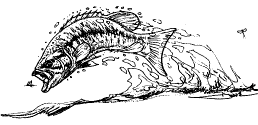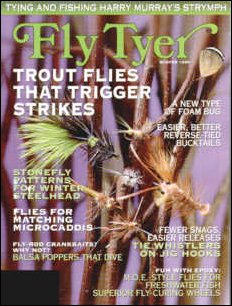
Check it Out

Headwaters:
a fish and angling art show
Here is a great selection of Hunting & Fishing magazines.
With 1200 Magazines to choose from you just can't go wrong
Help support this site by supporting our affiliates
All intellectual property and Pictures Copyright© of Robert Morger 1999. No reproductions of any material on this site is permitted without the express permission of the owner. All rights reserved.
The Onelist logo is a copyright of Onelist,Inc Copyright © 1998-1999, ONElist, Inc. All Rights
Reserved.
If you have suggestions or questions please contact rmorger@juno.com
Powered by counter.bloke.com
Puff Ant
tied by Gordon Mankins

| Puff Ant Tied by Gordon Mankins Hook: Mustad 94838 (extra short shank, 1x fine, size
16
Tying Instructions: An interest we all share is looking for new materials to use in tying flies. I really think the 'Puff' type material has a place in the tyer's box. 'Puff' refers to any commercial product that is designed to be applied to fabric and then subsequently expanded by the use of heat. It comes in assorted colors - I use them straight from the container or mix my own colors as needed. 'Puff' is available at hobby and some variety stores. After 'Puff' has completely dried, it can be expanded with indirect heat - I prefer an oven at 400F for 15 seconds - or just as ut has dried (unexpanded) to give you a natural feel and look. Since I have been using 'Puff', I have found numerous ways to incorporate it into fly patterns, from a tiny Baetis to a big hopper. This ant is a nice pattern for a beginner to tie as well as being a quick one for the more advanced tyer. 1. Prepare 'Puff'-on-a-string ahead of time by tying a series of half-knots pulled snug but by no means tight. Use 30# Dacron backing. Space half-knots as you desire for the size ant you are tying. I space half-knots 7/32nds apart for a size 16, Mustad 94838 hook.
2. Apply 'Puff' as desired on and around each half-knot. Hang the finished string up to dry completely - ie. at least 24 hours. 3. Prepare the hackle feather, sizing the pennaceous portion to be 1-1/2 the length of the gap. Trim off the excess plumaceous portion and clip a few barbs from each side of the rachis butt. 4. Tie in the thread at the center of the hook shank. Center 'Puff'-on-a-string segments on top of the hook shank as shown and hold them in place while wrapping thread around both the hook shank and the string section that connects two sections. Continue wrapping thread to the rear portion of the string section. 5. Tie in the hackle feather by the butt of the rachis with the shiny side toward the hook eye. Run the thread to the front portion of the string section. Close wrap the hackle feather forward three or more times. Lock it down with the waiting thread. Trim the excess hackle feather and wrap the thread forward under the front segment three or four close wraps. Whip finish. 6. Expand the 'Puff' on the finished fly in the oven. (I prefer 400F oven for 15 seconds.) Coat the segments with a thin mixture of head cement to give the ant a glossy finish. 7. Option: Pre-expand 'Puff'-on-a-string before tying onto the hook.
Fishing Tips: I fish ant patterns mostly in the summer months when ants are most numerous and often fall or are blown into the water. I cast ant patterns close to the stream banks where trout position themselves to feed on any ant that hiys the water, and in lakes where flying ants sometimes can cayse quite a surface bite. Look closely, those 'gulpers' may be feeding on flying ants and not on midge clusters. |


